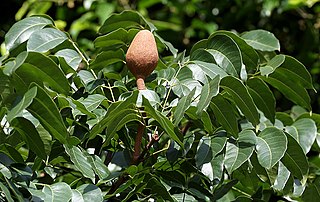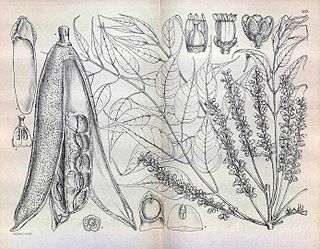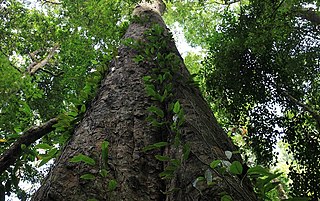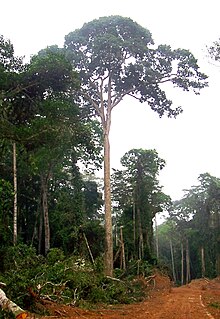
Mahogany is a straight-grained, reddish-brown timber of three tropical hardwood species of the genus Swietenia, indigenous to the Americas and part of the pantropical chinaberry family, Meliaceae. Mahogany is used commercially for a wide variety of goods, due to its coloring and durable nature. It is naturally found within the Americas, but has also been imported to plantations across Asia and Oceania. The mahogany trade may have begun as early as the 16th century and flourished in the 17th and 18th centuries. In certain countries, mahogany is considered an invasive species.

Meliaceae, the mahogany family, is a flowering plant family of mostly trees and shrubs in the order Sapindales.
African mahogany is a marketing name for several African trees whose wood has properties similar to New World mahogany species.

Entandrophragma cylindricum is a tree of the genus Entandrophragma of the family Meliaceae. It is commonly known as sapele or sapelli or sapele mahogany, as well as aboudikro, assi, and muyovu.

Khaya is a genus of five tree species in the mahogany family Meliaceae. The timber of Khaya is called African mahogany, and is valued as a substitute to American mahogany.

Swietenia is a genus of trees in the chinaberry family, Meliaceae. It occurs natively in the Neotropics, from southern Florida, the Caribbean, Mexico and Central America south to Bolivia. The genus is named for Dutch-Austrian physician Gerard van Swieten (1700–1772). The wood of Swietenia trees is known as mahogany.

Guarea is a genus of evergreen trees or shrubs in the family Meliaceae, native to tropical Africa and Central and South America. At their largest, they are large trees 20–45 m tall, with a trunk over 1 m diameter, often buttressed at the base. The leaves are pinnate, with 4–6 pairs of leaflets, the terminal leaflet present. They are dioecious, with male and female flowers on separate plants. The flowers are produced in loose inflorescences, each flower small, with 4–5 yellowish petals. The fruit is a four or five-valved capsule, containing several seeds, each surrounded by a yellow-orange fleshy aril; the seeds are dispersed by hornbills and monkeys which eat the aril.

Khaya anthotheca, with the common name East African mahogany, is a large tree species in the Meliaceae family, native to tropical Africa.

Swietenia macrophylla, commonly known as mahogany, Honduran mahogany, Honduras mahogany, or big-leaf mahogany is a species of plant in the Meliaceae family. It is one of three species that yields genuine mahogany timber (Swietenia), the others being Swietenia mahagoni and Swietenia humilis. It is native to South America, Mexico and Central America, but naturalized in the Philippines, Singapore, Malaysia and Hawaii, and cultivated in plantations and wind-breaks elsewhere.

Ruptiliocarpon is a monotypic genus of flowering plants in the family Lepidobotryaceae. The genus has only one species, Ruptiliocarpon caracolito. It is a tall tree that grows in several small isolated areas of Central and South America. It is known from Costa Rica, Colombia, Peru, and Suriname. It is locally common on hillsides and other well-drained areas, often in red clay, from near sea level to 400 m in elevation.
The Arboretum Lohbrügge (10 hectares), also known as the Arboretum der Bundesforschungsanstalt für Forst- und Holzwirtschaft or the Arboretum Lohbruegge der Bundesanstalt, is an arboretum with greenhouses maintained by the German Federal Research Center for Forestry and Forest Products (BFH). It is located at Leuschnerstrasse 91, Lohbrügge, Hamburg, Germany, and open by appointment.

Chukrasia tabularis, the Indian mahogany, is a deciduous, tropical forest tree species in the family Meliaceae. It is native to Bangladesh, Cambodia, China, India, Indonesia, Laos, Malaysia, Myanmar, Sri Lanka, Thailand, and Vietnam. Also introduced to many western countries such as Cameroon, Costa Rica, Nigeria, Puerto Rico, South Africa, and United States.

Toona sureni is a species of tree in the mahogany family. It is native to South Asia, Indochina, Malesia, China, and Papua New Guinea. It is commonly known as the suren toon, surian, limpaga, iron redwood or the red cedar. It is also known as the Indonesian mahogany or the Vietnamese mahogany. The species is a valuable timber tree.

Entandrophragma caudatum, or mountain mahogany, is a large Southern African tree belonging to the mahogany family and found in eastern and north eastern South Africa, Eswatini, Botswana, Angola, the Caprivi Strip region of Namibia, Zimbabwe, Zambia and Malawi. Kew currently recognises 12 other species of Entandrophragma, all with a tropical and sub-tropical African distribution.

Entandrophragma excelsum, is Africa's tallest indigenous tree native to tropical East Africa and occurs in eastern D.R.of the Congo, Rwanda, Burundi, Uganda, Tanzania, Malawi and Zambia. This species is scattered in areas of upland semi-deciduous forest, in mid-elevation and montane rainforest, at 1280 – 2150 metres elevation. It is locally also found in riverine forest.

The Victoria Basin forest–grassland mosaic is an ecoregion that lies mostly in Uganda and extends into neighboring countries. The ecoregion is centered north and west of Lake Victoria, with an outlier on the border of Ethiopia and South Sudan.

Okoubaka aubrevillei is a rare tropical tree species distributed throughout tropical rainforests of West and Central Africa that is thought to be the largest known parasitic plant.

Entandrophragma utile, called the sipo or utile, is a species of large tree in the genus Entandrophragma, native to nearly all of tropical Africa facing the Atlantic, from Guinea to Angola, and as far east as Uganda. The timber is traded as a tropical hardwood. It is sometimes called sipo mahogany. It shares many of the characteristics of genuine mahogany and is used as an alternative.
Entandrophragma angolense, called the tiama, is a tree species with alternate, pinnately compound leaves that are clustered at the ends of branches. It is within the family Meliaceae and has a wide distribution area, occurring in moist semi-deciduous and evergreen forest regions of Tropical Africa from Sierra Leone to Uganda.
















